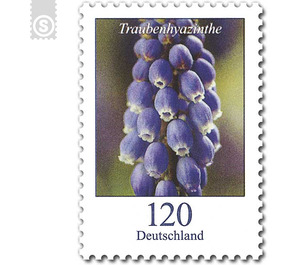Definitive Series "Flowers" - Grape hyacinth - Germany / Federal Republic of Germany 2019 - 120 Euro Cent
Theme: Flora
| Country | Germany / Federal Republic of Germany |
| Issue Date | 2019 |
| Face Value | 120.00 |
| Color | violet |
| Printing Type | offset |
| Stamp Type | Definitive |
| Item Type | Stamp |
| SID | 969919 |
| Dimensions | 22.00 x 30.00 |
| In 62 Wishlists | |
As one of the first in spring, the grape hyacinth provides a source of food for bees, bumblebees and many other insects. If you let the mostly blue beauty run wild, within a few years you can create enchanting seas of flowers. The flowers belonging to the asparagus plants (Asparagaceae) owe their name to the grape-shaped inflorescences. Since these exude a somewhat austere fragrance, the genus was given the botanical name "Muscari", which is derived from the Latin word "muscus" for "musk". The approximately 60 species of grape hyacinth originally come from the regions of North Africa, the Middle East, South and Southeastern Europe. After Central Europe some kinds arrived during the oriental period of garden art (1560-1620). The tender spring flowers bloom from March to May and reach a height between 10 and 30 centimeters. They are very undemanding, easy-care and hardy, so ideal for hobby gardeners. As long as no moisture accumulates, they thrive in every soil. But they especially like a sunny, warm location with loose, well drained soil.


